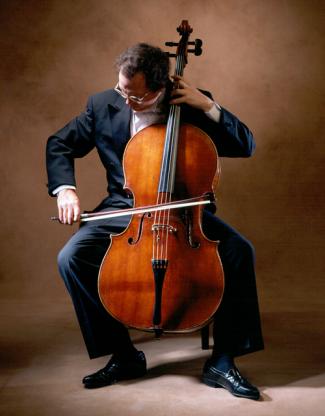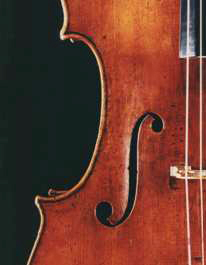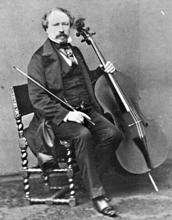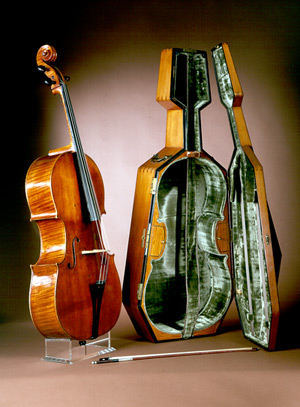- Home
- About
- About SCMS
- Directors
- Artists
- Vera Beths
- Steven Dann
- Marc Destrubé
- James Dunham
- Mark Fewer
- Eric Hoeprich
- Christopher Krueger
- Myron Lutzke
- Marilyn McDonald
- Douglas McNabney
- Mitzi Meyerson
- Pedja Muzijevic
- Anca Nicolau
- Jacques Ogg
- Loretta O'Sullivan
- Lambert Orkis
- Paolo Pandolfo
- William Purvis
- Marc Schachman
- Jaap Schröder
- Andrew Schwartz
- William Sharp
- Ian Swensen
- Lucy van Dael
- Ensembles
- Concerts
- The Collection
- Recordings
- Education
- Donate
The “Servais" Cello

The Stradivarius cello of 1701, known as the Servais, is unquestionably among the jewels of the Smithsonian’s collection. It is a magnificent instrument of incredible visual beauty, robust and bold in overall conception, yet refined in myriad details. Although it has had its original neck and other fittings replaced (see the discussion about this process on the page for the shop of Amati violin), it is in a remarkable state of preservation. Tonally, the Servais is virtually without peer, and often elicits from cellists who set bow to it the spontaneous exclamation, “Now, this is how a cello should sound!”
In designing this chef-d’oeuvre, Stradivari devised a brilliant synthesis of elements, detailed in the important monograph Antonio Stradivari: His Life and work, written in 1902 by William, Henry, and Arthur Hill, members of England’s most respected family of violin makers, dealers, and historians: “The Servais violoncello, as far as we know, stands alone. It is not only the sole example of the year 1701, but we believe it to be the only example which combines the grandeur of the pre-1700 instrument with the more masculine build which we could wish to have met with in the work of the master's earlier years.”
 The Servais is Stradivari’s last instrument of the large type used in the seventeenth century, and known variously as violone, bassetto, basse de violon, or bass violin. Over three cm. longer than a typical modern cello, it is one of only a few of his bassetti to have escaped the operation by which instruments of this size were reduced to conform in size to the “classically proportioned” cello developed by Stradivari by the end of the first decade of the 1700s. This kind of cutting operation, which involved the removal of a substantial amount of original material from the instrument, was in all likelihood first performed early in the nineteenth century, and has continued virtually up to the present day, all too often with lamentable results. Bernhard Romberg, a prominent cellist of the early 1800s, wrote in his tutor of 1840: “The instrument on which I play is by Antonio Stradivari, dated 1711, a small pattern. By the expression small pattern I mean not that it is below the proper size, but only that Stradivari also made instruments of a larger size, which are too large for the modern style of playing.” The shift away from large instruments towards the end of the seventeenth century coincided with the invention of metal-overspun gut strings, which allowed makers to obtain cleanly-speaking low pitches from the new, denser strings without the longer length required for the same pitches by the older, all-gut strings. The exceptional resonance of the Servais cello is particularly apparent in its low register. Its darkly luminous tone easily overshadows that of any lesser instrument, and was no doubt its great attraction for Adrien-François Servais (1807-1866), the Belgian cellist who owned the instrument for over two decades, and whose custody helped preserve the instrument in its original grand dimensions.
The Servais is Stradivari’s last instrument of the large type used in the seventeenth century, and known variously as violone, bassetto, basse de violon, or bass violin. Over three cm. longer than a typical modern cello, it is one of only a few of his bassetti to have escaped the operation by which instruments of this size were reduced to conform in size to the “classically proportioned” cello developed by Stradivari by the end of the first decade of the 1700s. This kind of cutting operation, which involved the removal of a substantial amount of original material from the instrument, was in all likelihood first performed early in the nineteenth century, and has continued virtually up to the present day, all too often with lamentable results. Bernhard Romberg, a prominent cellist of the early 1800s, wrote in his tutor of 1840: “The instrument on which I play is by Antonio Stradivari, dated 1711, a small pattern. By the expression small pattern I mean not that it is below the proper size, but only that Stradivari also made instruments of a larger size, which are too large for the modern style of playing.” The shift away from large instruments towards the end of the seventeenth century coincided with the invention of metal-overspun gut strings, which allowed makers to obtain cleanly-speaking low pitches from the new, denser strings without the longer length required for the same pitches by the older, all-gut strings. The exceptional resonance of the Servais cello is particularly apparent in its low register. Its darkly luminous tone easily overshadows that of any lesser instrument, and was no doubt its great attraction for Adrien-François Servais (1807-1866), the Belgian cellist who owned the instrument for over two decades, and whose custody helped preserve the instrument in its original grand dimensions.
 Servais acquired the cello on one of his first trips to Russia. According to one account, he was loaned the instrument by the Princess Youssoupova for an exceptionally important concert before Tsar Nicholas I. Praised lavishly by the monarch following his performance, Servais demurely credited the kindness of the Princess in loaning him the instrument. Hearing this, and still ebullient from the concert, she cried, “It was not a loan, but a gift!” whereupon the Tsar congratulated her on the munificence of her action, and expressed his pride at Russia’s ability to offer a distinguished artist such a souvenir of his visit. A conflicting account, however, relates that Servais had persuaded the Princess to purchase the instrument for him, a design thwarted when her death intervened. “Her people,” continues this report, "seeing matters in a very different light, were not at all disposed to fall in with the player’s plans. Servais, however, was determined to achieve his object and threatened that, if they were not willing to put into execution the Princess’ good intentions in his regard, he would publish the many intimate letters he had received from her, with the result that, rather than incur the scandal such a proceeding would invoke, the family decided to “pay up!” However it came to him, Servais valued the instrument highly. When he feared it lost after a particularly difficult sledge trip across the Russian steppes, his despair was abject (the instrument was discovered the next day lying in its case in the snow: the leather binding of the case had been gnawed by wolves). Fortunately, the instrument has had a pacific recent history (including over fifty years in the hands of the amateur cellist Charlotte Bergen, who donated the Servais to the Smithsonian in 1981), and its preservation in the United States National Museum assures its continued protection.
Servais acquired the cello on one of his first trips to Russia. According to one account, he was loaned the instrument by the Princess Youssoupova for an exceptionally important concert before Tsar Nicholas I. Praised lavishly by the monarch following his performance, Servais demurely credited the kindness of the Princess in loaning him the instrument. Hearing this, and still ebullient from the concert, she cried, “It was not a loan, but a gift!” whereupon the Tsar congratulated her on the munificence of her action, and expressed his pride at Russia’s ability to offer a distinguished artist such a souvenir of his visit. A conflicting account, however, relates that Servais had persuaded the Princess to purchase the instrument for him, a design thwarted when her death intervened. “Her people,” continues this report, "seeing matters in a very different light, were not at all disposed to fall in with the player’s plans. Servais, however, was determined to achieve his object and threatened that, if they were not willing to put into execution the Princess’ good intentions in his regard, he would publish the many intimate letters he had received from her, with the result that, rather than incur the scandal such a proceeding would invoke, the family decided to “pay up!” However it came to him, Servais valued the instrument highly. When he feared it lost after a particularly difficult sledge trip across the Russian steppes, his despair was abject (the instrument was discovered the next day lying in its case in the snow: the leather binding of the case had been gnawed by wolves). Fortunately, the instrument has had a pacific recent history (including over fifty years in the hands of the amateur cellist Charlotte Bergen, who donated the Servais to the Smithsonian in 1981), and its preservation in the United States National Museum assures its continued protection.
 The Servais Strad cello has been used in a number of SCMS recordings, played primarily by the Dutch cellist Anner Bylsma, who has remarked: “Playing this instrument, I am bounded not by any shortcomings in my equipment, but only by the limits of my imagination.”
The Servais Strad cello has been used in a number of SCMS recordings, played primarily by the Dutch cellist Anner Bylsma, who has remarked: “Playing this instrument, I am bounded not by any shortcomings in my equipment, but only by the limits of my imagination.”


